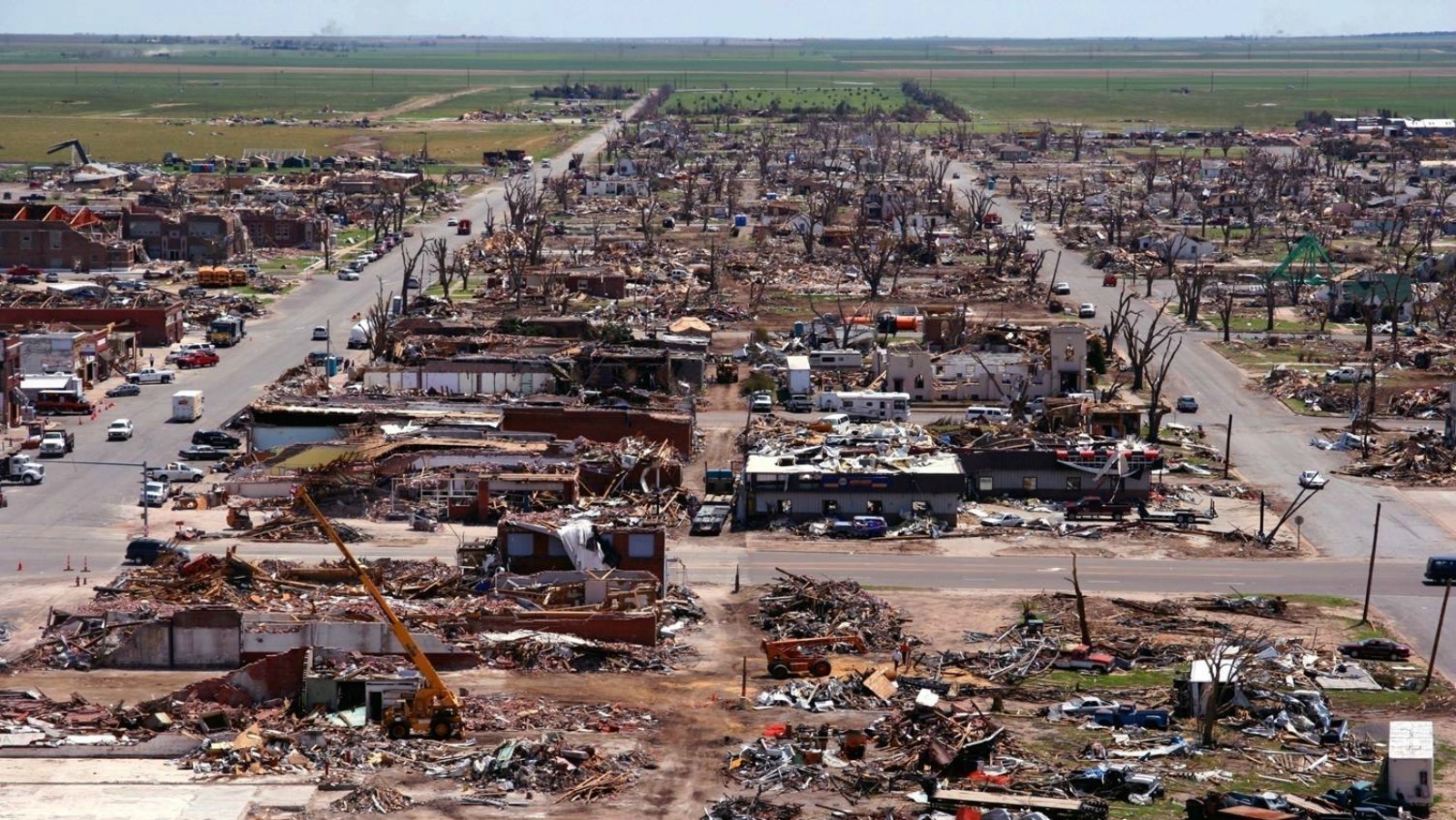If I were to tell you this is a story about a tornado in Kansas, it would probably bring to mind a certain doe-eyed girl and her little dog. Well, sometimes tornadoes transport girls and their adorable pets to magical lands. Other times they level entire towns.
That is what happened the night of May 4, 2007, when an EF-5 tornado (for non-Kansans, that’s a really freaking big — the biggest, in fact) nearly two miles wide hit the town of Greensburg, a farming community in south-central Kansas. Almost all of the 1,383 residents lost their homes, nine died, and the town was left looking like this:
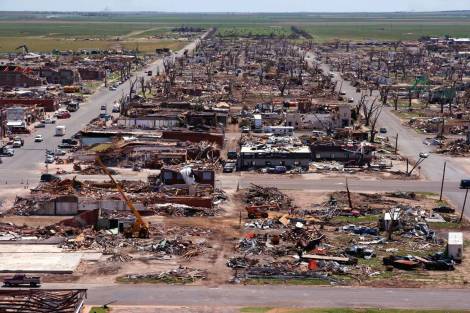
The destruction was sudden and the rebuilding process was daunting. However, as thoughts on how to rebuild swirled, a number of people thought, “Hey, what if we rebuilt Greensburg with ‘green’ principles? Ha, guys, see what I did there? Do you get it? … Guys?”
To which many of their neighbors responded with a “yes, we do get it” and a “yeah, we thought of that idea, too.” Even before the tornado hit, the community was shrinking and its population getting older. Greensburg residents knew they needed a new strategy. The tornado, awful as it was, provided a clean slate.
The greening of Greensburg was a way to rebrand the community, says the town’s current mayor, Bob Dixson, but more importantly, it was about “building a community back as our ancestors built for us — a community to last.”
In the years that followed, Greensburg would rise from the rubble, replete with LEED-certified municipal buildings; a “net metering policy” that makes solar and wind power more affordable for residents; and a new town master plan [ginormous PDF!] that includes things like green corridors and a walkable downtown. The efforts attracted gobs of state and federal money, stories in the national press, and a reality TV show produced by Leo DiCaprio.
Six years after disaster struck Greensburg, the media circus has largely left town. But as a part of our Get Small project at Grist, I thought I’d check in and see if a community that was nearly wiped off the map might have lessons for other small towns that are looking to spruce up their images and slim down their carbon footprint.
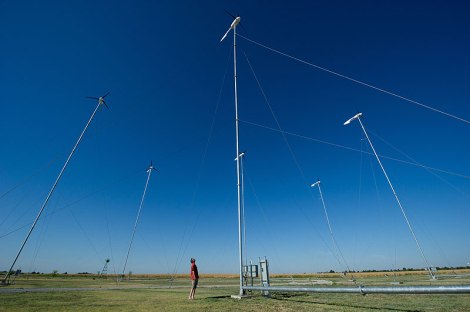
Dennis Schroeder, NRELThese wind turbines popped up at the local John Deere dealership.
My first question was how a small town on the Plains managed to embrace sustainability in the first place. Turns out that from the beginning of the rebuilding effort, some community members saw sustainability as a natural extension of rural and conservative sensibilities. “A strong value of rural folks is self-sufficiency,” says Daniel Wallach, who moved to the Greensburg area a few years before the tornado, and started the nonprofit Greensburg Greentown to help the community with its endeavor into sustainability. “You hear it all the time in conservative circles when you’re talking about government finance: People are really clear on not wanting to leave financial burden on kids. But what about the other kinds of burdens we leave on kids?”
But as anyone who has ever lived in a small town will understand, Greensburg residents weren’t about to let themselves be called names like “treehugger” or “turbineboy.” This new emphasis on sustainability had to be authentic.
Dixson credits community meetings in the first days following the tornado for putting people on the same page. “It was critical right off the bat that we start meeting in a big tent outside of town,” he says. “We did everything out there.” Each entity in town, from hospital higher-ups to city officials and nonprofit leaders, would share their thoughts inside that tent in a space where everyone could hear. “That helped tie everything together, so we were working together,” Dixson says.
The early rebuilding efforts generated a tremendous amount of energy, and some remarkable examples of eco-friendly ingenuity. Local resident Brad Estes says greening Greensburg “was a 24/7 job.” Early on, many were unsure if they wanted to spend, in some cases, over twice as much in building costs to do it the green way. However, Estes notes that those that made a commitment to a sustainable rebuild “feel like it’s paying back in lower energy prices and better conservation of resources.”
Estes is now the director of wind operations for BTI Wind Energy, a local wind turbine company that was born from the aftermath of the tornado. The business sells small-scale turbines for residential and commercial use. Over the past few years, it’s expanded from being just a local supplier to installing and servicing turbines in other states and Canada — the perfect inverse of the Keystone XL tar-sands pipeline.
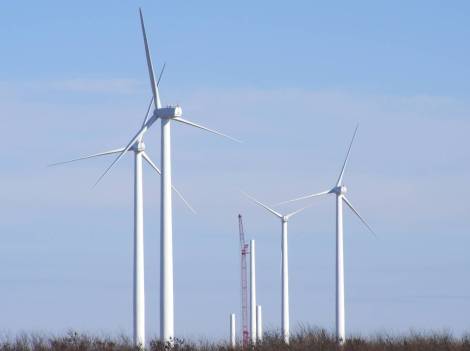
On a larger scale, the city of Greensburg teamed up with John Deere Renewable Energy and the Kansas Power Pool to build a production-scale wind farm five miles outside of town. Estes describes the wind farm the same way some dude at the bar might describe his ’67 Pontiac GTO: “Yeah, there are 10 units of 1.25 megawatt Suzlon turbines, generating 12.5 megawatts in total.” The juice flows into the Kansas Power Pool, which feeds a number of local municipalities, but Greensburg receives renewable energy credits and the bragging rights to getting 100 percent of its power from the wind.
That 100 percent wind power only refers to what is imported from elsewhere, however. Estes estimates that around 8 percent of Greensburg’s energy is generated from assorted wind turbines and solar panels scattered around the town itself. That’s thanks to Greenburg’s net-metering policy, which which allows resident to install rooftop solar panels or backyard wind turbines, feed any leftover power right into the grid, and then get paid for it — the full retail price. This allows residents to pay off the up-front cost of panels and turbines more quickly, bringing the cost of renewables within reach of more of the populace.
And thanks to all the new high-efficiency buildings, including the hospital, the local John Deere dealership, and the arts center, Greensburg is saving $200,000 annually in energy costs on 13 of its largest buildings, according to a recent study by the the National Renewable Energy Laboratory. Private residences got into the act — examples here, here, or here — and there’s this cool map showing all of Greensburg’s sustainable building projects.
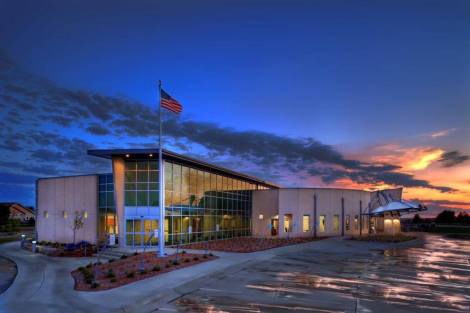
The new Kiowa County Memorial Hospital is certified LEED Platinum.
Greensburg is understanding sustainability in its own terms. “Being green” in Greensburg is not a primary motivator, but a product of respecting resources for future generations, working toward self-sufficiency, and adapting to the economic and physical climate.
The true test of the new approach, however, will come with time. Will the new green infrastructure attract businesses and jobs, or will Greensburg become what Mayor Dixson calls a “green ghost town”? On that front, it may still be too soon to say, but there are positive signs. While the population was nearly halved after the tornado (from 1,398 to 775), those that stayed seem to be sticking around, and many of the businesses have returned: the hardware store, the coffee shop, banks, the pharmacy.
And there’s this: In a 2009 statement, Greensburg’s school superintendent, Darin Headrick, said that “Before the tornado, if you asked most of the high school kids about their plans for the future, they’d say the same thing: ‘I’m going to go away to college and never come back.’ Now, they say, ‘I’m going to go to college and then come back.’ They see things here that they can impact.”
Maybe there’s a future for these hardscrabble rural towns after all.

